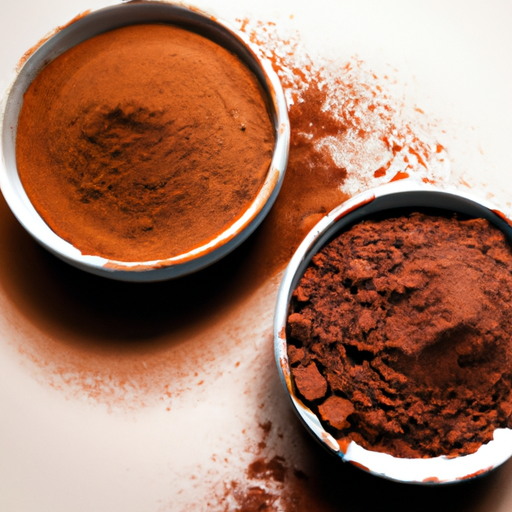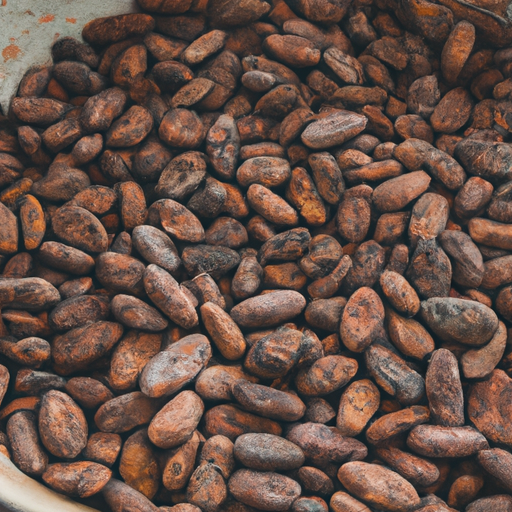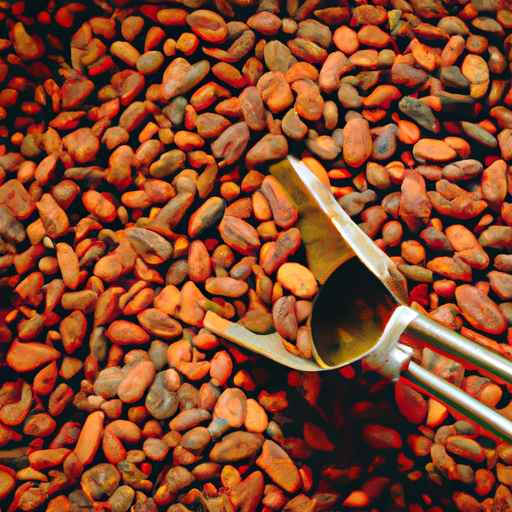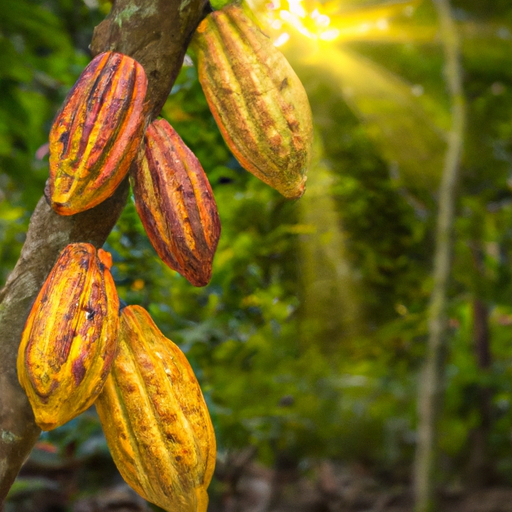Have you ever thought about the distinction between unsweetened cocoa and raw cacao powder? Let me clarify this cocoa confusion for you. Both unsweetened cocoa and raw cacao powder originate from beans of the cacao tree, but it is the process they go through that differentiates them.
Unsweetened cocoa is made by roasting the cacao beans at high temperatures, which gives it a rich, deep flavor. On the other hand, raw cacao powder is made by cold-pressing unroasted cacao beans, preserving more of its natural nutrients and antioxidants.
But it’s not just about the production process; these two ingredients also differ in terms of nutritional content, health benefits, and flavor profile. They each have their own unique qualities that make them suitable for different culinary applications.
So, whether you’re a chocolate lover or a health-conscious foodie, understanding the difference between unsweetened cocoa and raw cacao powder will help you make informed choices in the kitchen. Let’s dive deeper into this chocolatey world and explore the nuances of these delightful ingredients.
Key Takeaways
- Unsweetened cocoa is made by roasting cacao beans at high temperatures, while raw cacao powder is made by cold-pressing unroasted cacao beans.
- Unsweetened cocoa has a rich, deep flavor and intense, bitter taste, while raw cacao powder has a milder taste and smoother flavor.
- Raw cacao powder preserves more natural nutrients and antioxidants compared to unsweetened cocoa.
- Both unsweetened cocoa and raw cacao powder offer various health benefits, including supporting cardiovascular health, enhancing mood, boosting cognitive function, and promoting overall well-being.
Production Process of Unsweetened Cocoa and Raw Cacao Powder
Get ready to discover the fascinating production process behind unsweetened cocoa and raw cacao powder! Both products start with the cocoa bean, but the production techniques differ slightly.
To make unsweetened cocoa, the cocoa beans are first fermented, dried, and roasted. Then, they are ground into a fine powder, removing the cocoa butter to create a low-fat product. Quality control measures ensure that the cocoa powder is free from impurities and maintains its rich flavor.
On the other hand, raw cacao powder undergoes a similar process, but with lower temperatures during roasting to preserve more of the natural nutrients. This results in a higher nutritional content compared to unsweetened cocoa.
So, now that we understand the production process, let’s delve into the nutritional content of these two products.
Nutritional Content of Unsweetened Cocoa and Raw Cacao Powder
When it comes to the nutritional content of unsweetened cocoa and raw cacao powder, there are a few key points to consider.
First, both contain high levels of antioxidants, which are important for protecting the body against oxidative stress and inflammation.
Second, they are both rich in minerals and vitamins, such as magnesium, iron, and vitamin C, which support various bodily functions.
Lastly, both unsweetened cocoa and raw cacao powder are good sources of fiber and protein, which promote digestive health and help keep you feeling full and satisfied.
Antioxidant Content
To really boost your antioxidant intake, opt for unsweetened cocoa or raw cacao powder, which are like a powerful shield protecting your body against free radicals. These superfoods are packed with antioxidants, which are compounds that help combat oxidative stress and reduce the risk of chronic diseases.
Here is a comparison of the antioxidant content of unsweetened cocoa and raw cacao powder:
| Antioxidant | Unsweetened Cocoa | Raw Cacao Powder |
|---|---|---|
| Flavanols | High | High |
| Polyphenols | Moderate | High |
| Catechins | Moderate | High |
| Epicatechins | Moderate | High |
As you can see, both unsweetened cocoa and raw cacao powder are rich in antioxidants, but raw cacao powder takes the lead with higher levels of flavanols, polyphenols, catechins, and epicatechins. This makes it a great choice for antioxidant-rich recipes.
Next, let’s explore the mineral and vitamin content of these two superfoods.
Mineral and Vitamin Content
The mineral and vitamin content of these two superfoods is worth exploring, as they offer a range of essential nutrients to enhance your overall health and well-being.
When comparing unsweetened cocoa and raw cacao powder, it is important to note that both are rich sources of minerals such as magnesium, iron, and potassium. These minerals play crucial roles in various bodily functions, including muscle and nerve function, blood pressure regulation, and energy production.
Additionally, both superfoods are packed with vitamins, particularly B vitamins and antioxidants, which support brain health and help protect against chronic diseases.
Furthermore, unsweetened cocoa and raw cacao powder contain flavonoids, which have been associated with numerous health benefits, including reduced inflammation and improved heart health.
Moving on to the next section about fiber and protein content, these superfoods also provide a good amount of these essential nutrients.
Fiber and Protein Content
Get ready to discover the impressive fiber and protein content found in these two superfoods!
Both unsweetened cocoa and raw cacao powder are excellent sources of dietary fiber, which offers numerous benefits for our digestive system. Fiber helps regulate bowel movements, prevents constipation, and promotes overall gut health. Additionally, fiber can lower cholesterol levels and support heart health.
As for protein, both unsweetened cocoa and raw cacao powder contain a decent amount, making them a good option for those looking to increase their protein intake. Protein is essential for muscle repair and growth, and it also helps keep us feeling full and satisfied.
Moving on to the next section, let’s explore the various health benefits of unsweetened cocoa and raw cacao powder.
Health Benefits of Unsweetened Cocoa and Raw Cacao Powder
Unsweetened cocoa and raw cacao powder offer numerous health benefits that contribute to overall well-being.
First, they promote cardiovascular health by improving blood flow and reducing the risk of heart disease.
Additionally, these ingredients have mood-enhancing properties, helping to alleviate stress and enhance feelings of happiness.
Lastly, unsweetened cocoa and raw cacao powder have been shown to improve cognitive function, enhancing focus and memory.
Cardiovascular Health
Contrary to popular belief, indulging in a bit of raw cacao powder might just make your heart sing with joy. Here’s why:
-
Cardiovascular disease prevention: Raw cacao powder is rich in flavonoids, which have been linked to a reduced risk of heart disease. These compounds help improve blood flow, reduce inflammation, and prevent the formation of blood clots.
-
Blood pressure regulation: The flavanols in raw cacao powder have been found to have a positive impact on blood pressure levels. Studies have shown that consuming raw cacao can help lower both systolic and diastolic blood pressure, leading to a healthier cardiovascular system.
-
Antioxidant powerhouse: Raw cacao powder contains a high concentration of antioxidants, which help protect the heart and blood vessels from damage caused by free radicals. This can further contribute to cardiovascular health.
-
Improved insulin sensitivity: Research suggests that the flavonoids in raw cacao powder may enhance insulin sensitivity, helping to regulate blood sugar levels and reduce the risk of diabetes, a condition often associated with cardiovascular complications.
With its impressive cardiovascular benefits, raw cacao powder is not only a delicious treat but also a heart-healthy choice.
Moving on to the next topic, let’s explore how it can enhance our mood.
Mood Enhancement
Indulging in a bit of raw cacao powder can instantly lift your spirits and boost your mood. This natural mood-enhancer is packed with beneficial compounds that stimulate the release of endorphins and serotonin, the ‘feel-good’ hormones in the brain.
The mood-boosting effects of raw cacao powder can be attributed to its high content of flavonoids, which have been shown to have positive effects on mood and reduce symptoms of anxiety and depression.
Additionally, the presence of phenylethylamine (PEA) in raw cacao powder helps to increase dopamine levels, further contributing to an improved mood.
So, the next time you experience chocolate cravings, reach for raw cacao powder to satisfy your sweet tooth while also giving your mood a natural pick-me-up.
Speaking of picking-me-ups, let’s move on to the next section about cognitive function.
Cognitive Function
Boost your brainpower by incorporating a sprinkle of this magical cocoa dust into your daily routine. Here are four ways in which unsweetened cocoa and raw cacao powder can enhance your cognitive function and promote brain health:
-
Improved focus and concentration: The flavonoids present in cocoa and cacao powder have been shown to increase blood flow to the brain, enhancing cognitive performance and attention span.
-
Enhanced memory: The antioxidants found in these powders can protect brain cells from oxidative stress, helping to improve memory and prevent age-related cognitive decline.
-
Increased mental clarity: The natural stimulants in cocoa and cacao, such as caffeine and theobromine, can sharpen mental alertness and boost overall cognitive function.
-
Mood regulation: Consuming cocoa and cacao powder can stimulate the production of endorphins and serotonin, promoting a positive mood and reducing stress.
By incorporating unsweetened cocoa or raw cacao powder into your daily routine, you can give your brain an extra boost. Now, let’s dive into the flavor profiles of these two magical ingredients.
Flavor Profile of Unsweetened Cocoa and Raw Cacao Powder
When it comes to the flavor profile of unsweetened cocoa and raw cacao powder, two key points to consider are the bitterness and intensity of the taste.
Unsweetened cocoa tends to have a more intense and bitter flavor compared to raw cacao powder, which has a slightly milder taste.
Additionally, both unsweetened cocoa and raw cacao powder have distinct aromas and tasting notes that can range from earthy and nutty to fruity and floral, depending on the variety and origin.
In terms of culinary uses and pairings, both can be used in a variety of recipes such as baking, smoothies, and hot beverages, but raw cacao powder is often preferred for its more complex flavor profile.
Bitterness and Intensity
The bitter and intense flavors of unsweetened cocoa and raw cacao powder can transport your taste buds to a rich and decadent world of chocolate.
When it comes to bitterness, unsweetened cocoa tends to have a more pronounced bitter taste compared to raw cacao powder. This is because unsweetened cocoa is processed at a higher temperature, which intensifies its bitterness.
On the other hand, raw cacao powder is made by cold-pressing unroasted cocoa beans, resulting in a milder and less bitter flavor profile.
In terms of intensity, unsweetened cocoa has a stronger and more robust flavor, while raw cacao powder offers a smoother and more subtle taste.
Moving on to the next section, let’s explore the delightful aromas and tasting notes of these chocolate delights.
Aromas and Tasting Notes
Indulging in the seductive aromas and tantalizing tasting notes of these chocolate delights is like being whisked away on a velvety, flavor-filled journey. Unsweetened cocoa and raw cacao powder both possess distinct aromas and tasting notes that add depth to any recipe. Unsweetened cocoa powder often exhibits rich and earthy aromas with a hint of bitterness, while raw cacao powder tends to have a more intense and complex aroma with floral notes and fruity undertones. These differences in aromas and tasting notes can greatly influence the overall flavor profile of a dish. For example, unsweetened cocoa powder may lend a deep and robust chocolate flavor, while raw cacao powder can bring a more nuanced and nuanced taste. Transitioning into the subsequent section about ‘culinary uses and pairings’, these unique characteristics make both unsweetened cocoa and raw cacao powder versatile ingredients in various recipes and culinary creations.
Culinary Uses and Pairings
Let’s now delve into the culinary uses and pairings of unsweetened cocoa and raw cacao powder. Both of these ingredients are incredibly versatile and can be used interchangeably in recipes such as baking, making chocolate drinks, and adding depth of flavor to savory dishes.
Unsweetened cocoa powder is widely used in baking, providing a rich chocolate flavor to cakes, cookies, and brownies. It can also be used to make hot chocolate or added to smoothies for a chocolatey twist.
On the other hand, raw cacao powder has an intense and slightly fruity flavor profile. It is often used in raw desserts, energy bars, or sprinkled over yogurt and oatmeal for added nutritional benefits.
Now, let’s explore the various culinary applications of unsweetened cocoa and raw cacao powder in more detail.
Culinary Applications of Unsweetened Cocoa and Raw Cacao Powder
Unsweetened cocoa and raw cacao powder have a wide range of culinary applications. They can be used to create delicious chocolate desserts such as brownies, cakes, and cookies. The intense flavor of unsweetened cocoa adds a bold chocolate taste that complements the sweetness of these treats. On the other hand, raw cacao powder is often used in smoothie recipes, providing a natural and healthier alternative to traditional cocoa. Its raw and minimally processed form retains more nutrients and antioxidants, making it a popular choice for health-conscious individuals. Both unsweetened cocoa and raw cacao powder can be used interchangeably in various recipes, giving you the flexibility to experiment with different flavors. So go ahead and explore the fascinating world of chocolate making and processing.
Chocolate Making and Processing
In chocolate making and processing, there are several key points to consider.
Firstly, the differences in chocolate production can affect the taste and texture of the final product.
Secondly, the cocoa butter content plays a crucial role in determining the smoothness and richness of the chocolate.
Lastly, understanding the tempering and melting properties of chocolate is essential for achieving the desired consistency and appearance.
These factors all contribute to creating high-quality, delicious chocolate.
Differences in Chocolate Production
When it comes to chocolate production, you’ll find that unsweetened cocoa and raw cacao powder have distinct differences. Unsweetened cocoa is made by pressing the fat, or cocoa butter, out of the cocoa beans, leaving behind a dry powder. On the other hand, raw cacao powder is made by cold-pressing unroasted cocoa beans, which retains more of the natural cocoa butter. This results in a more intense and bitter flavor compared to unsweetened cocoa.
Here’s a comparison of the two:
| Unsweetened Cocoa | Raw Cacao Powder |
|---|---|
| Made from roasted cocoa beans | Made from unroasted cocoa beans |
| Less intense flavor | More intense and bitter flavor |
| Lower in cocoa butter content | Higher in cocoa butter content |
| Commonly used in baking and cooking | Popular in raw desserts and smoothies |
| Widely available in most grocery stores | Often found in health food stores |
Moving on to the next section about cocoa butter content, it’s important to understand how it affects the overall taste and texture of chocolate.
Cocoa Butter Content
To truly appreciate the rich taste and smooth texture of chocolate, it’s important to understand the impact of cocoa butter content.
Cocoa butter is a crucial component of chocolate. It is responsible for its velvety mouthfeel and luscious flavor.
Unsweetened cocoa and raw cacao powder differ in their cocoa butter content. Unsweetened cocoa has had most of its cocoa butter removed, resulting in a lower fat content. On the other hand, raw cacao powder retains a higher percentage of cocoa butter, giving it a richer and creamier texture.
For those looking to avoid or reduce their intake of cocoa butter, there are cocoa butter alternatives and substitutes available. These options can provide similar texture and flavor to chocolate without the use of cocoa butter.
Understanding cocoa butter content is essential for achieving the desired consistency and taste in chocolate recipes.
Moving on to tempering and melting properties, let’s explore how these factors affect chocolate making.
Tempering and Melting Properties
Get ready to experience the mind-blowing magic of tempering and melting properties in chocolate making!
Tempering is a crucial step in chocolate production. It involves carefully controlling the temperature to achieve a smooth and glossy finish. There are various tempering techniques, such as seeding, tabling, or using a tempering machine. These methods ensure that the cocoa butter crystals in the chocolate are properly aligned, resulting in a stable and shiny texture.
On the other hand, melting methods refer to how the chocolate is heated and melted. This can be done using a double boiler, microwave, or even a sous vide machine. Each method has its own advantages and drawbacks, and the choice depends on the desired outcome and available equipment.
With an understanding of tempering techniques and melting methods, we can now delve into the labeling and packaging of unsweetened cocoa and raw cacao powder.
Labeling and Packaging of Unsweetened Cocoa and Raw Cacao Powder
The labeling and packaging of unsweetened cocoa and raw cacao powder demonstrate subtle distinctions in their respective ingredients and production processes.
To comply with labeling regulations, both products must clearly state that they are unsweetened and specify the cocoa content. However, there are additional requirements for raw cacao powder. It must be labeled as ‘raw’ and indicate that it has not been heated above a certain temperature to preserve its nutritional value.
Quality control is also important in the labeling and packaging process to ensure that the products meet the standards set by regulatory authorities. These regulations and quality control measures help consumers make informed choices about the products they purchase.
Transitioning into the next section, price and availability of unsweetened cocoa and raw cacao powder vary depending on factors like brand and location.
Price and Availability of Unsweetened Cocoa and Raw Cacao Powder
Now, let’s dive into the exciting world of pricing and availability for these delectable cocoa products.
When it comes to price comparison, unsweetened cocoa tends to be more affordable than raw cacao powder. This is because raw cacao powder goes through less processing and retains more of its natural nutrients, making it a premium product.
However, the availability of both products may vary depending on your location. Unsweetened cocoa powder is more commonly found in grocery stores and can be easily purchased online.
On the other hand, raw cacao powder may be a bit harder to find and may require a visit to specialty health food stores or online retailers.
With the knowledge of the price and availability of these cocoa products, let’s move on to the next section about tips for using them in recipes.
Tips for Using Unsweetened Cocoa and Raw Cacao Powder in Recipes
Ready to elevate your recipes? Here are some handy tips for using these rich and flavorful cocoa products. When it comes to cocoa powder vs cacao powder, both can add depth and richness to your dishes. Cocoa powder is made by grinding roasted cocoa beans, while cacao powder is made from raw, unroasted cocoa beans. This slight difference in processing can affect the flavor profile and nutritional content.
To incorporate unsweetened cocoa or raw cacao powder into your recipes, consider the following tips:
- Use cocoa powder for a more intense chocolate flavor, perfect for baking brownies, cakes, and cookies.
- Use cacao powder for a slightly fruity and bitter taste, great for smoothies, hot chocolate, and raw desserts.
- Adjust the sweetness in your recipes when using cacao powder, as it is less sweet than cocoa powder.
- Remember that both cocoa and cacao powders contain antioxidants, fiber, and minerals, but raw cacao powder retains more of these nutrients due to minimal processing.
By understanding the differences between cocoa powder and cacao powder, you can make informed choices to enhance your culinary creations while enjoying the health benefits they provide.
Frequently Asked Questions
Can unsweetened cocoa or raw cacao powder be used interchangeably in recipes?
I prefer using unsweetened cocoa or raw cacao powder interchangeably in dessert recipes. Both have a slightly different taste, with raw cacao powder being more intense and bitter. Overall, they provide a rich chocolate flavor to your desserts.
Are there any potential side effects or risks associated with consuming unsweetened cocoa or raw cacao powder?
There are potential health risks associated with consuming unsweetened cocoa or raw cacao powder. It is important to consume them in recommended serving sizes to avoid negative effects on the cardiovascular system and digestive system.
Can unsweetened cocoa or raw cacao powder be used in baking or cooking for people with specific dietary restrictions, such as gluten-free or vegan diets?
Unsweetened cocoa and raw cacao powder can be used as substitutes in gluten-free baking. They are also suitable for vegan diets and can be used in various recipes like vegan brownies and chocolate smoothies.
How do unsweetened cocoa and raw cacao powder compare to other chocolate products in terms of their health benefits and nutritional content?
Unsweetened cocoa and raw cacao powder, compared to other chocolate alternatives, offer impressive health benefits due to their high antioxidant content. They can be a nutritious addition to a diet, supporting overall well-being.
Are there any specific storage recommendations or shelf-life considerations for unsweetened cocoa and raw cacao powder?
For optimal storage of unsweetened cocoa and raw cacao powder, it is recommended to keep them in a cool, dry place in a tightly sealed container. Both have a long shelf life of up to two years.
What is the difference between raw cacao powder and cocoa powder?
Raw cacao processing into cocoa involves roasting the cacao beans at high temperatures, which reduces the nutritional content. Raw cacao powder is made by cold-pressing unroasted beans, preserving more antioxidants and nutrients. Cocoa powder, on the other hand, is usually heated and may contain added sugar or other ingredients.
Conclusion
In conclusion, there are some key differences between unsweetened cocoa and raw cacao powder.
While both are derived from the same source, the cacao bean, their production processes and nutritional content vary.
Unsweetened cocoa is made by roasting and grinding the beans, whereas raw cacao powder is made by cold-pressing the beans to retain more nutrients.
One example of the health benefits of raw cacao powder is its high antioxidant content, which has been linked to improved heart health.
Incorporating raw cacao powder into your diet may help reduce the risk of cardiovascular diseases.










